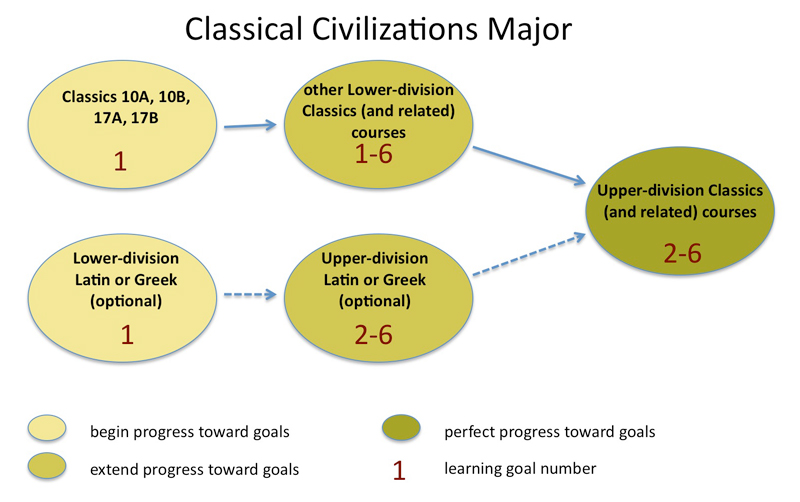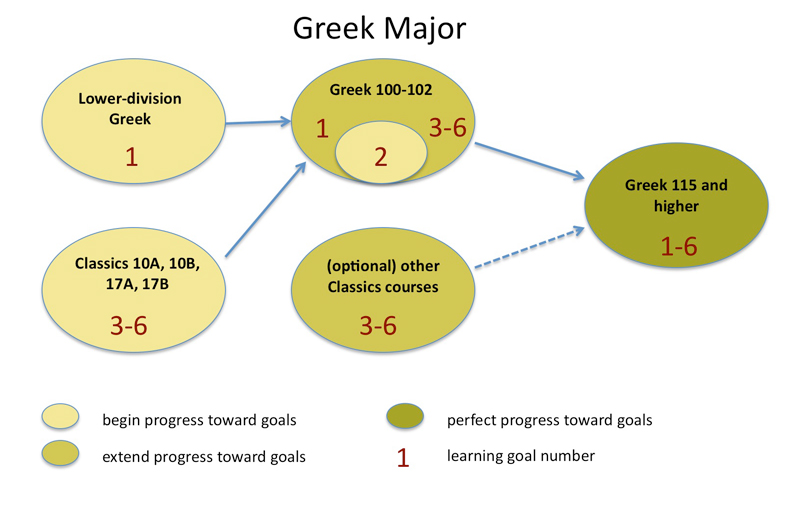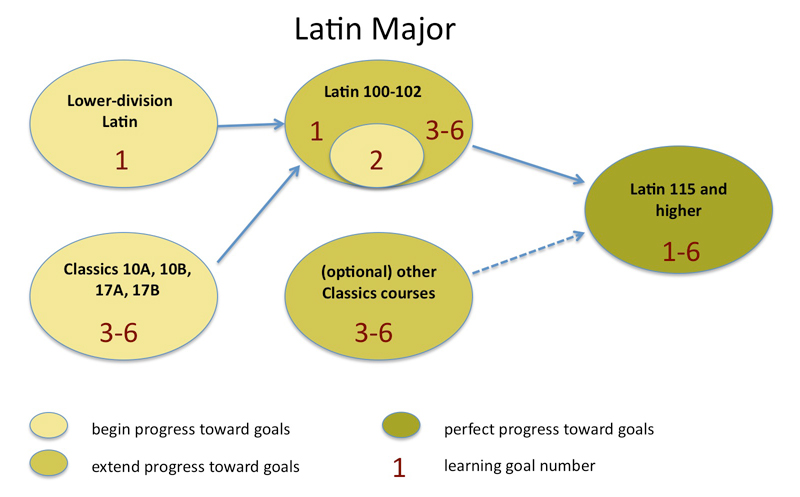Undergraduate Student Learning Goals
In 2007-2009 the Department, as part of a campus-wide initiative, strove to articulate more explicitly the goals and expectations of its undergraduate curriculum and to consider possible mechanisms for evaluating its success in meeting those goals. The process provoked helpful discussion among the faculty and thus a stronger sense of common purpose and shared standards in undergraduate teaching. The resulting statement also provides to Classics students a framework for understanding the intellectual coherence of their major program, the contribution that various individual courses make to it, and the skills and knowledge that they need to master to meet the expectations of a successful major program.
The learning goals should be understood in the context of the mission statement of the Department of Classics. The first two components of that statement are especially relevant to undergraduate teaching and are repeated here:
- To give students across the University access to the literature, history, archaeology, mythology and philosophy of the ancient Greek and Roman world through an array of undergraduate courses on classical culture in translation. These courses introduce students to texts, artefacts, and ideas that are worth studying both in their own right and as abidingly influential elements in the imagination and history of later cultures. Such study deepens students' understanding of present-day issues by inculcating a sense of historical perspective that takes account of both the differences and the continuities between contemporary and ancient cultures.
- To enable undergraduates to immerse themselves in the language and culture of ancient Greece and Rome through its majors in Greek, Latin, and Classical Civilizations. These majors equip students with knowledge and analytical skills that can be applied in many areas (e.g., law, politics, business, biosciences, computer science and media) as well as providing essential preparation for graduate study in Classics, Comparative Literature, Philosophy, and other fields.
Statement of Program Learning Goals for Undergraduate Students
The Department has four majors, and while most goals apply to all majors, two are expressed in slightly different terms for each major. KEY: CL = Classical Languages; G = Greek; L = Latin; CC = Classical Civilizations
1.
- (CL) Acquire a basic grounding in the vocabulary, morphology, and syntax of classical Greek and Latin.
- (G) Acquire a basic grounding in the vocabulary, morphology, and syntax of classical Greek.
- (L) Acquire a basic grounding in the vocabulary, morphology, and syntax of classical Latin.
- (CC) Acquire a basic understanding of ancient Greek and Latin texts (in translation) and/or material culture, including major monuments, sites and works of art.
2.
- (CL, G, L) Practice the skills needed to use dictionaries, grammars, and other resources to read intermediate texts accurately and to deal comfortably with at least some advanced texts in the original language(s).
- (CC) Demonstrate a more advanced knowledge of a particular concentration within Classics (Classical Art and Archaeology, or Classical History and Culture, or Greek Language, or Latin Language)
3. Learn to identify and understand key events, institutions, personalities, places, and concepts of ancient Greek and Roman culture.
4. Gain a critical awareness of continuities and differences between and within cultures and of ideologies of gender, group identity, social status, and political organization.
5. Demonstrate the ability to interpret texts and material culture and to understand the implications of interpretive methods.
6. Demonstrate the ability to synthesize a well-organized argument from textual or other evidence and to express it in formal English prose.
The Goals in Relation to the Courses of the Majors
Below are visual representations of the paths through major requirements and the relation of different courses to the six goals listed above. Click on any image to see a larger version.
Assessment
The department is launching a pilot project for assessment in the 2009-10 academic year that will sample the achievement of graduating majors in the areas of critical thinking and (where appropriate) of language mastery. The assessment will have two components:
(1) Language mastery. Each semester, one course from the series Greek 115-125 and one from the series Latin 115-122 will be designated in advance to provide a sampling for language translation. The instructor includes a sight translation on the final exam (or, in rare cases, provides a comparably diagnostic translation passage on the final or tests the class separately near the end of the semester with such a passage). When the exams have been corrected, the instructor records the results of that passage on a separate sheet, showing only SID and a grade expressed as x points earned/maximum points available, and this sheet will be submitted to the Department Chair, who will preserve a copy and provide another copy to the person(s) designated to analyze the information.
(2) Critical thinking. The sample is student-initiated. Majors in their senior year are informed that they are required to designate for separate assessment one of the papers they are writing in a Classics course in their senior year. (Students may regard this as a kind of capstone to their major. Students writing an honors thesis will normally designate the thesis.) The professor records the student's grade for the paper anonymously, keyed only to the student's SID number, and in addition evaluates the student's performance along a set of criteria as set out in the following table. Each criterion is awarded a maximum of 6 points, for a maximum total of 36 points. The results are transmitted to the Department Chair, who will preserve a copy and provide another copy to the person(s) designated to analyze the information.
Table of Rubrics for Evaluation of Student Writing
(Download PDF version of table.)
| Excellent | Acceptable | Unacceptable | |
| Overall conception, thesis |
-Conception of the project shows an original analysis of materials, beyond what was discussed in class.
-Thesis offers an interesting and arguable claim. -Thesis is of the right scope for the assignment. -Key concepts and terms are generally defined clearly and used consistently. |
-Conception of the project synthesizes coherently the ideas discussed in class and shows an accurate understanding of material.
-Thesis offers a non-trivial and arguable claim. -Thesis is of the right scope for the assignment. -Key concepts are used consistently but may not be fully or rigorously defined. |
-Conception of project is incoherent or does not show an understanding of class material.
-There is no thesis or the thesis offers an obvious or non-provable claim. -Thesis is too big or too small to be handled within the scope the assignment. -Key concepts are generally left undefined and/or are used inconsistently. |
| Interpretive skills |
-The paper offers accurate observations about texts and/or material evidence that are not obvious and shows an ability to perceive detail and read analytically.
-The paper demonstrates the ability to interpret texts and/or material culture and to understand the implications of interpretive methods. |
-The paper offers accurate observations about texts and/or material evidence, but the observations do not go substantially beyond the most obvious level.
-The paper demonstrates a basic understanding of interpretive methods and their implications, but does not push the analysis very far or does not show a full understanding of the implications of interpretive methods. |
-The paper either offers too few concrete observations about texts and/or material evidence or offers observations that are inaccurate or misleading.
-The paper either offers no interpretation of the text and/or material evidence or offers interpretations that are illogical, unconvincing or that otherwise show a lack of understanding of interpretive methods and their implications. |
| Mastery of relevant information and concepts |
-Information throughout, or with very rare exceptions, is factually correct.
-Treatment demonstrates throughout, or with very occasional and minor lapses, a grasp of which key events, institutions, personalities, places, and concepts of ancient Greek and/or Roman culture are relevant to the topic, and of how they are relevant. -Treatment demonstrates throughout, or with very occasional and minor lapses, a critical awareness of continuities and differences between and within cultures and of ideologies of gender, group identity, social status, and political organization (assuming that the assignment offers the opportunity for demonstrating such awareness). |
-Information is mostly correct, though there may be several small errors.
-Although the treatment does not demonstrate a fully secure grasp of which key events, institutions, personalities, places, and concepts of ancient Greek and/or Roman culture are relevant to the topic, and of how they are relevant, its grasp is mostly along the right lines. - Although it lacks full assurance, treatment demonstrates to a reasonable degree a critical awareness of continuities and differences between and within cultures and of ideologies of gender, group identity, social status, and political organization (assuming that the assignment offers the opportunity for demonstrating such awareness). |
-Information is often incorrect or incomplete in fundamental points.
-Treatment demonstrates little or no grasp of which key events, institutions, personalities, places, and concepts of ancient Greek and/or Roman culture are relevant to the topic, and of how they are relevant. -Treatment demonstrates little or no critical awareness of continuities and differences between and within cultures and of ideologies of gender, group identity, social status, and political organization (assuming that the assignment offers the opportunity for demonstrating such awareness). |
| Argumentation, Organization, Use of evidence |
-Argumentation overall
--shows an excellent grasp of logic; --generally acknowledges and accounts for potential counter-evidence and contrary interpretations; --uses mostly concrete examples that are well-chosen and well-analyzed. -Use of evidence always or almost always engages fully with the contextual implications of the examples (e.g. historical context, genre of text). -The paper has a clear development of ideas throughout its length. -All or almost all logical steps in the argument are accounted for within the paper. |
-Argumentation
--is mostly logical, but may have some errors (e.g. over-generalizing); --shows a consciousness of counter-evidence and contrary interpretations but may not fully acknowledge and account for them; --uses relevant examples, but examples that may not be specific enough or analyzed well enough to show their relation to the argument. -Use of evidence generally shows an understanding of the context from which each example is taken (e.g. historical context, genre of text). -The paper has a clear development of ideas overall but some steps in the argument may be missing or insufficiently discussed. |
-Argumentation
-- has serious lapses in logic (e.g. circular reasoning); -- fails to acknowledge counter-evidence and contrary interpretations; -- fails to use examples in support of claims or uses examples that are irrelevant. -Examples are often chosen and used without reference to context. -The paper lacks a clear development of ideas overall. -One or more key steps in the argument are missing or insufficiently expressed. |
| Research |
-The paper uses only relevant and authoritative sources and includes (where appropriate) more than just the most obvious sources.
-All sources are cited appropriately and consistently throughout. -The paper accurately represents the claims and arguments of its sources and discusses them in a rigorous, inquiring way. |
-The paper uses relevant and authoritative sources, though may also include one or two less suitable sources; only the most obvious sources are used.
-All sources are cited appropriately, though there may be some inconsistency in citation style. -The paper cites sources accurately (i.e. not misrepresenting the argument) but without taking full account of the author’s aims or assumptions. |
-The paper uses too few sources, or sources that are irrelevant or not reliable.
-There is significant inconsistency or confusion in the citation style. -The paper misrepresents or fails to understand the arguments of sources. NB: Plagiarism is different from just “unacceptable” work, so that is not covered here. |
| Paragraphing; Clarity and precision of expression; Orthography and punctuation |
-All or almost all paragraphs make a clearly delineated step in the argument.
-The serial arrangement of paragraphs and the transitions between paragraphs help the reader to follow the argument. -Language throughout the paper is clear, precise and easy to follow. -Words are used appropriately. -Syntax is correct and sentence structure is used to best advantage for clarity and readability. -Spelling and punctuation conform to the standards of formal academic prose. |
-Most paragraphs make a clearly delineated step in the argument, but there may be some repetition between paragraphs.
-Most paragraphs are coherent and well placed in sequence, but either the design of individual paragraphs or the serial arrangement of paragraphs may not be optimal for expressing the argument. -Transitions are mostly clear and logical but there may be some gaps or confusion. -Language throughout is readable and clear, though there may be some limited instances of imprecise word choice, awkward or unclear phrasing or an overuse of a relatively restricted vocabulary. -Syntax is generally correct, but there may be some small errors. -Spelling and punctuation generally conform to standards of formal academic prose, but there may be some errors. |
-Arrangement of paragraphs is haphazard and does not follow the logic of the argument.
-There is significant repetition of ideas between paragraphs. -Individual paragraphs are either not coherent, not relevant to the overall argument. -Transitions between paragraphs are neglected or are badly expressed. -Language throughout is unclear or imprecise. -There are significant and/or multiple errors in word usage. -There are significant and/or multiple errors in syntax. -There are significant and/or multiple errors in spelling and/or punctuation. |






